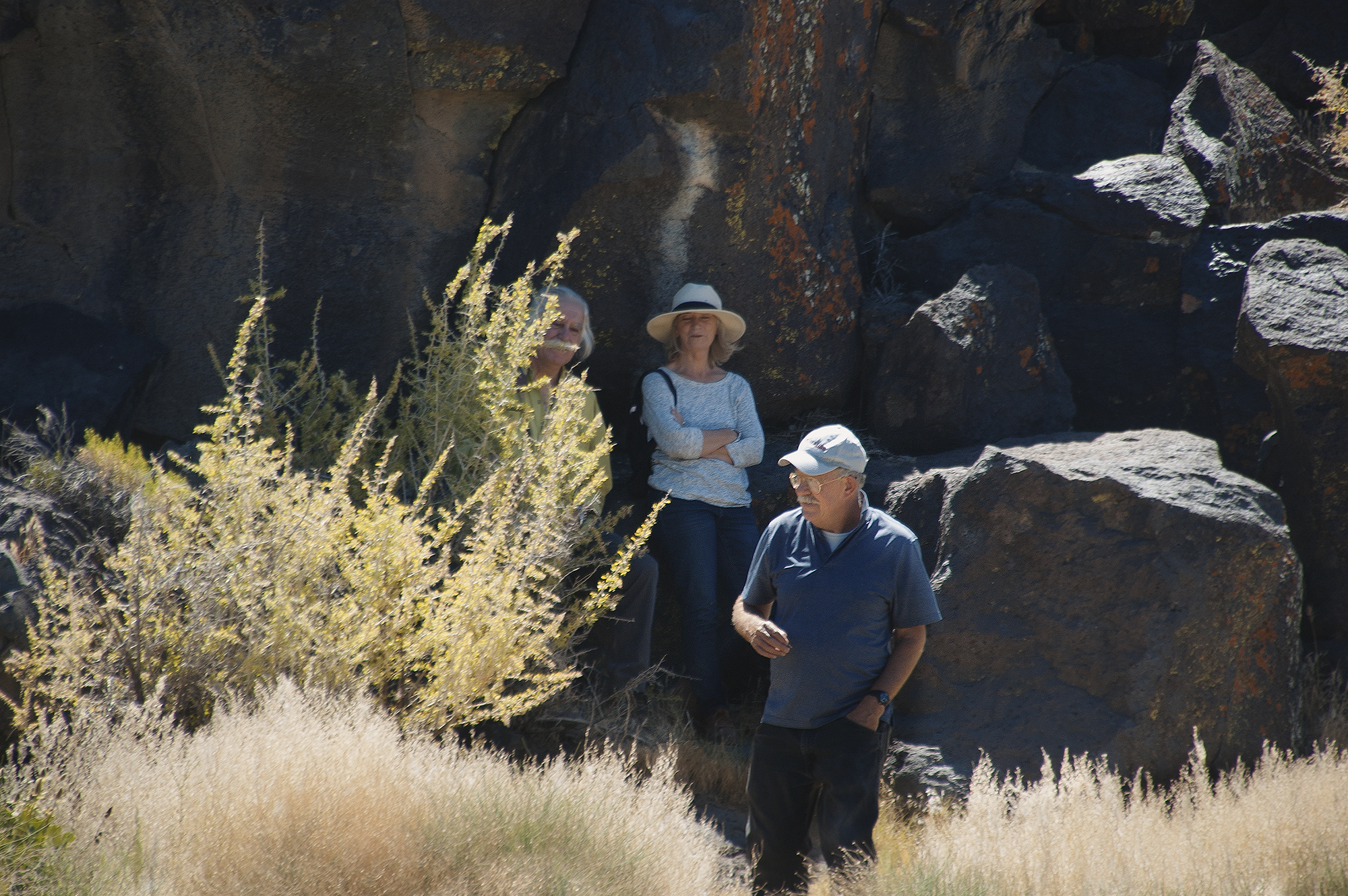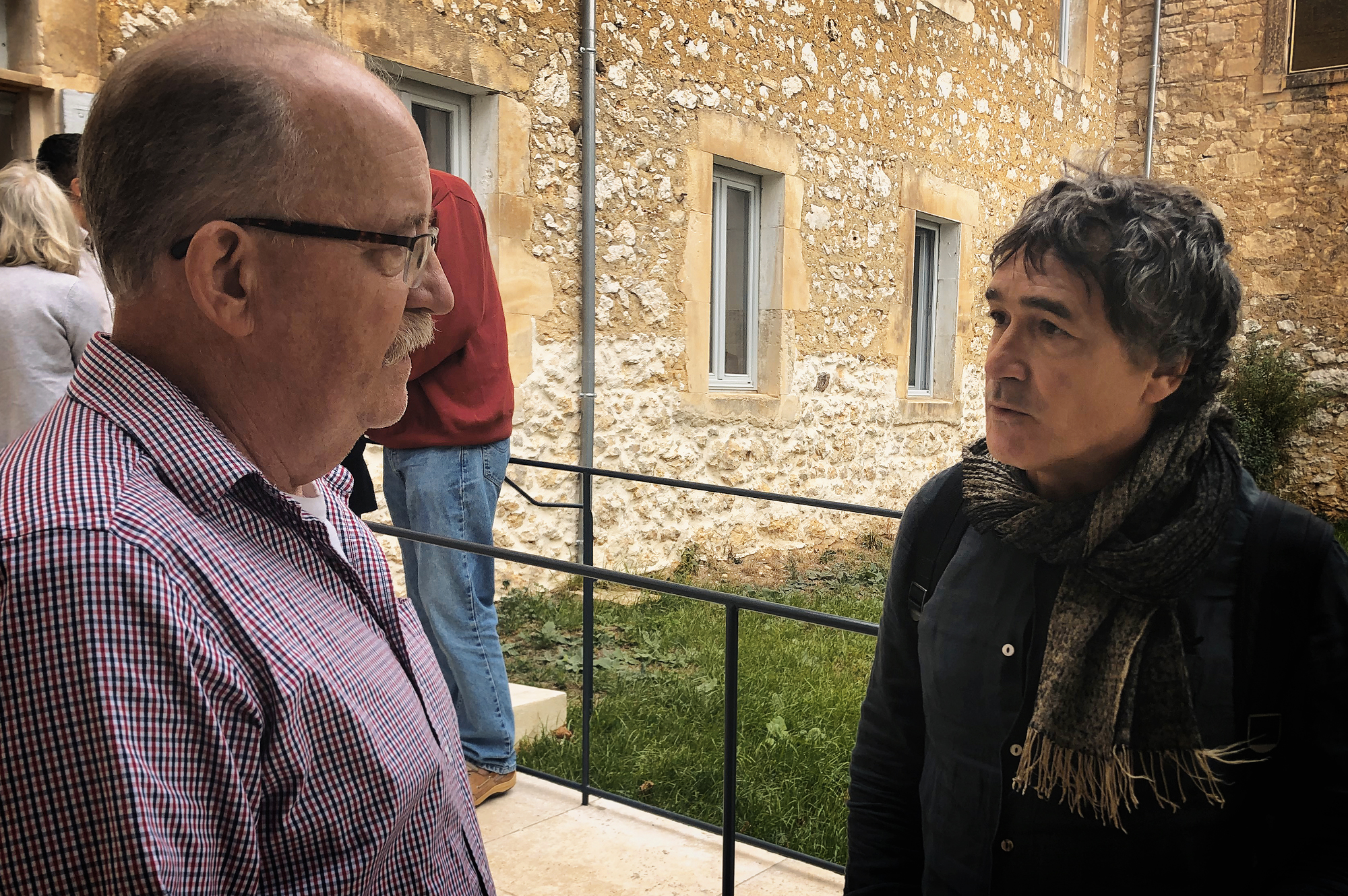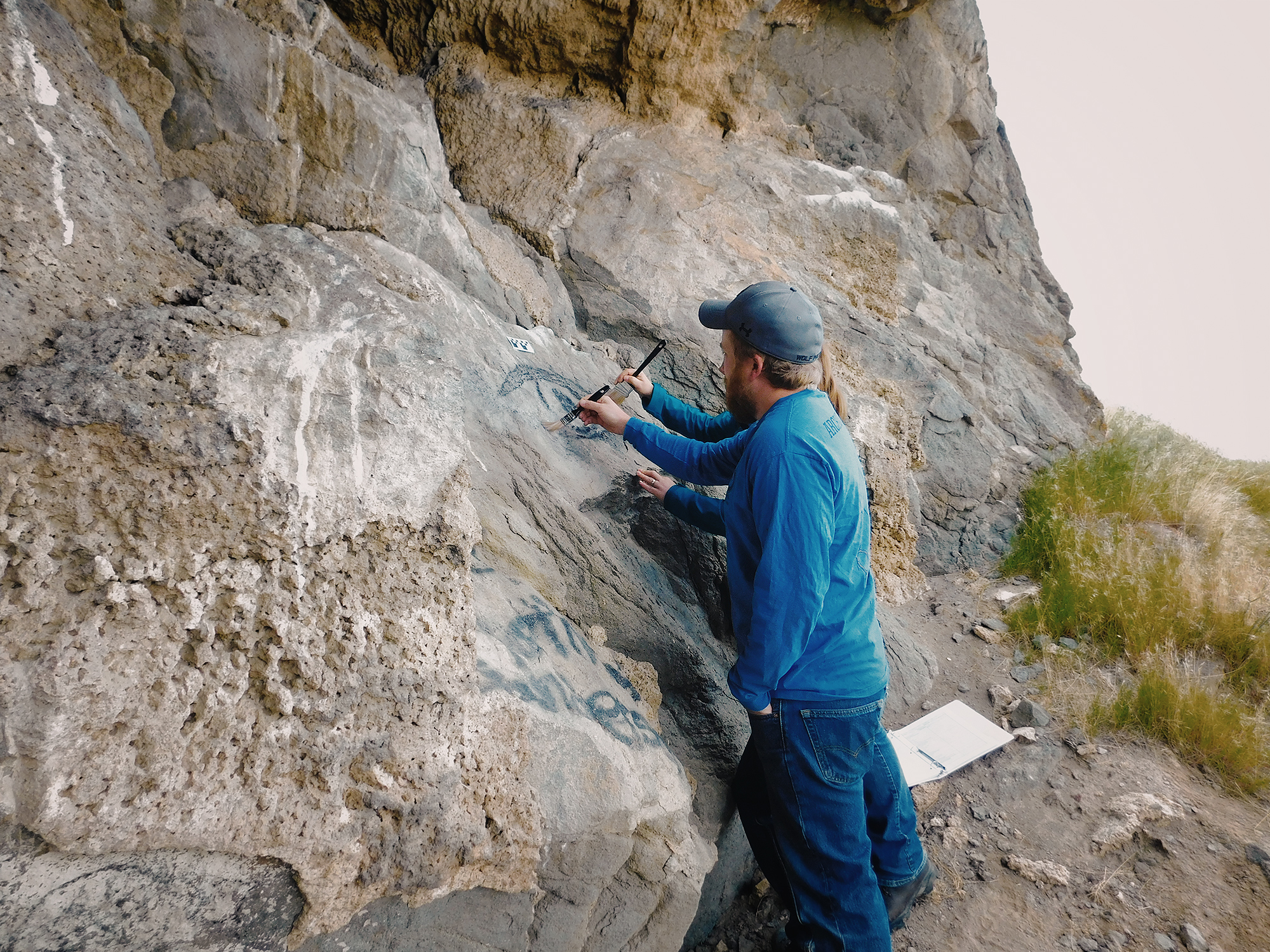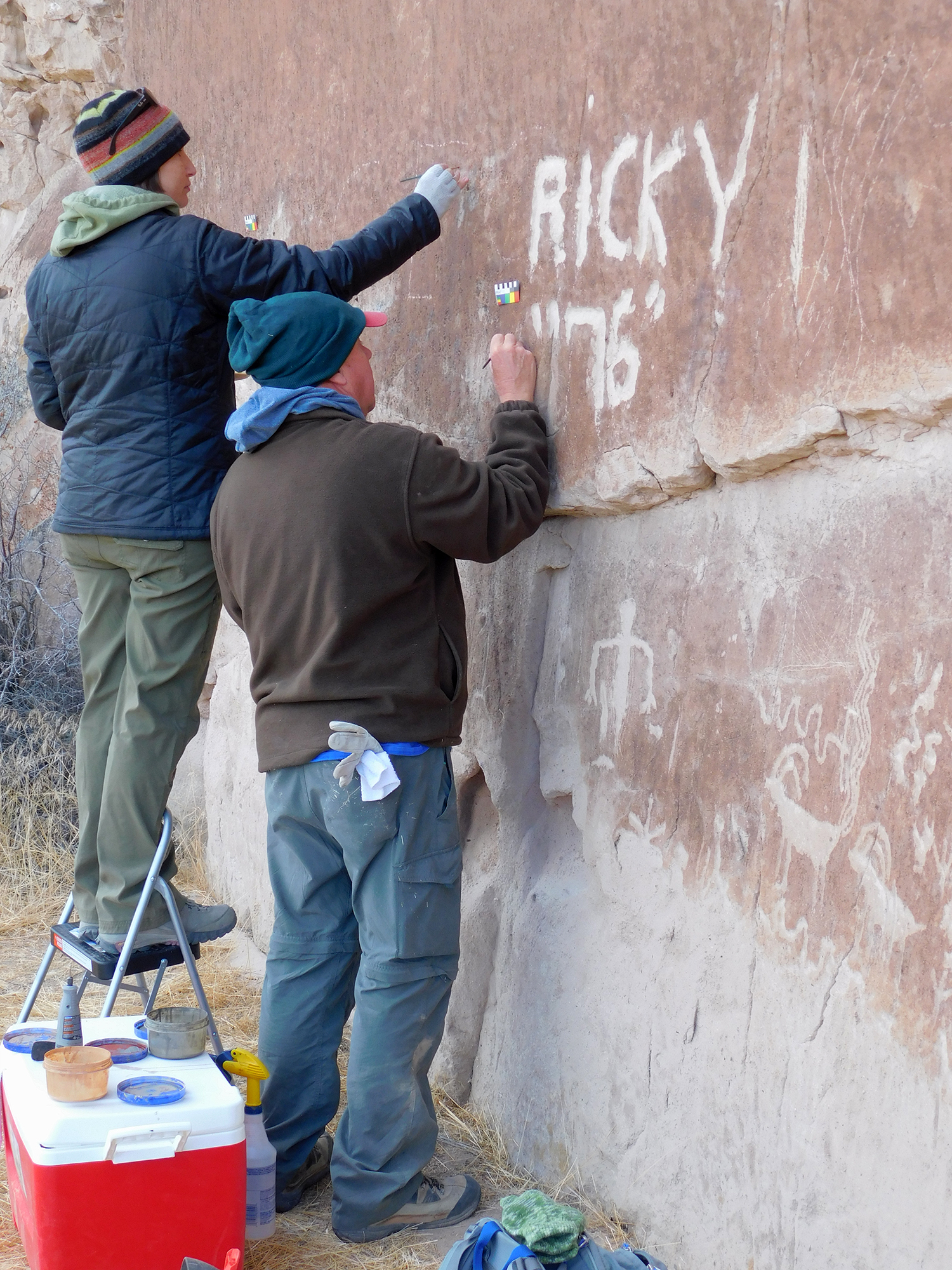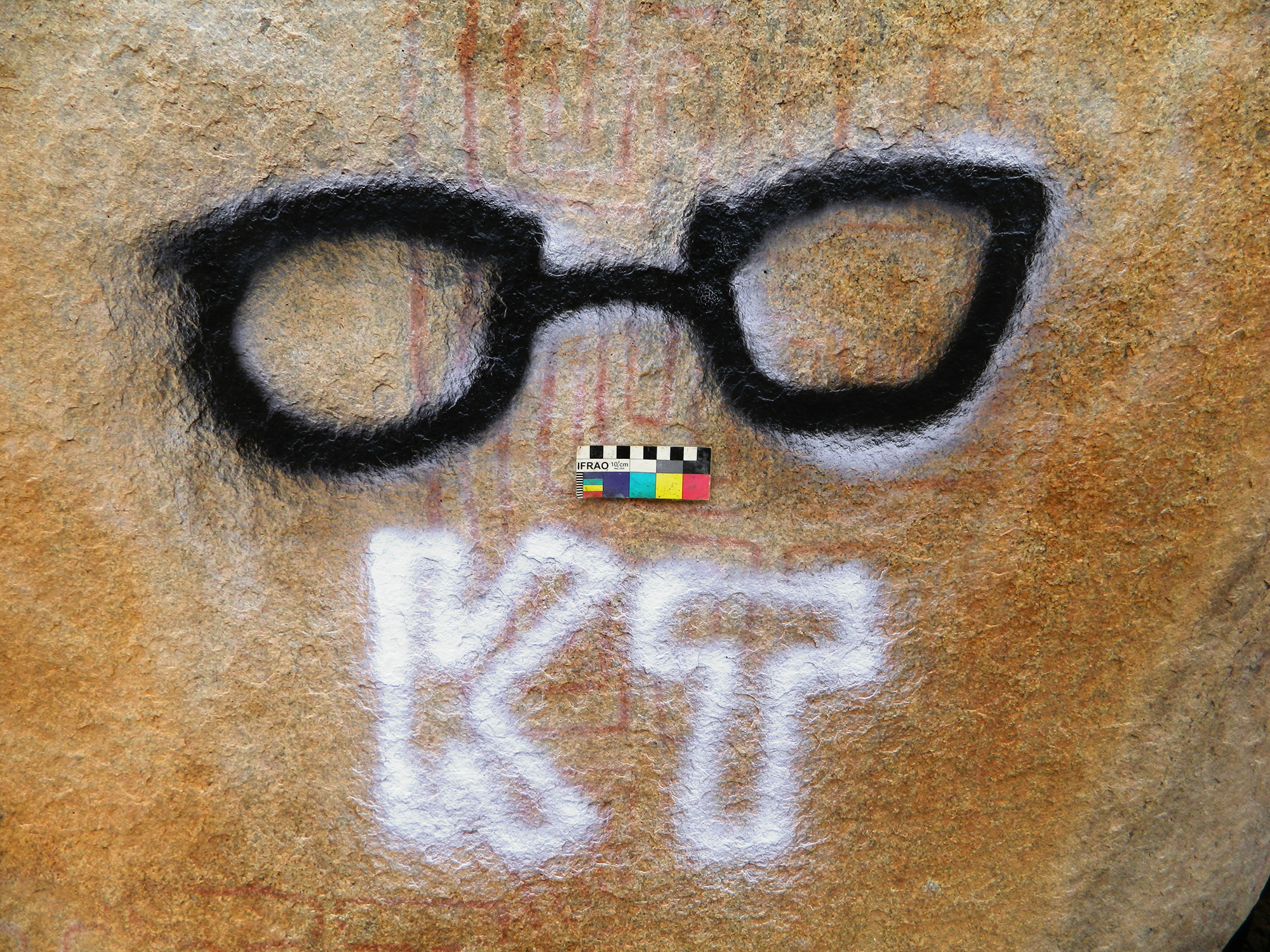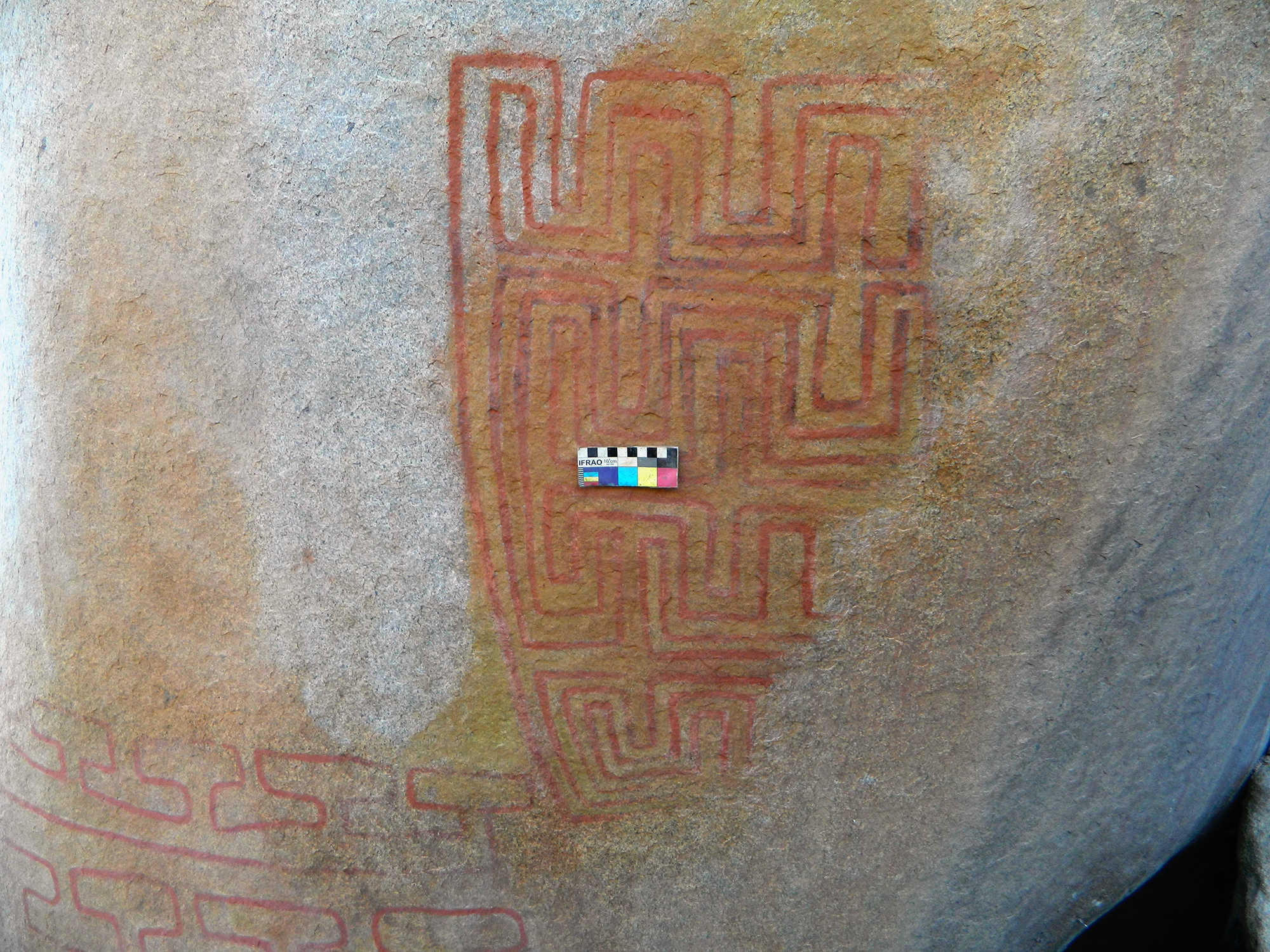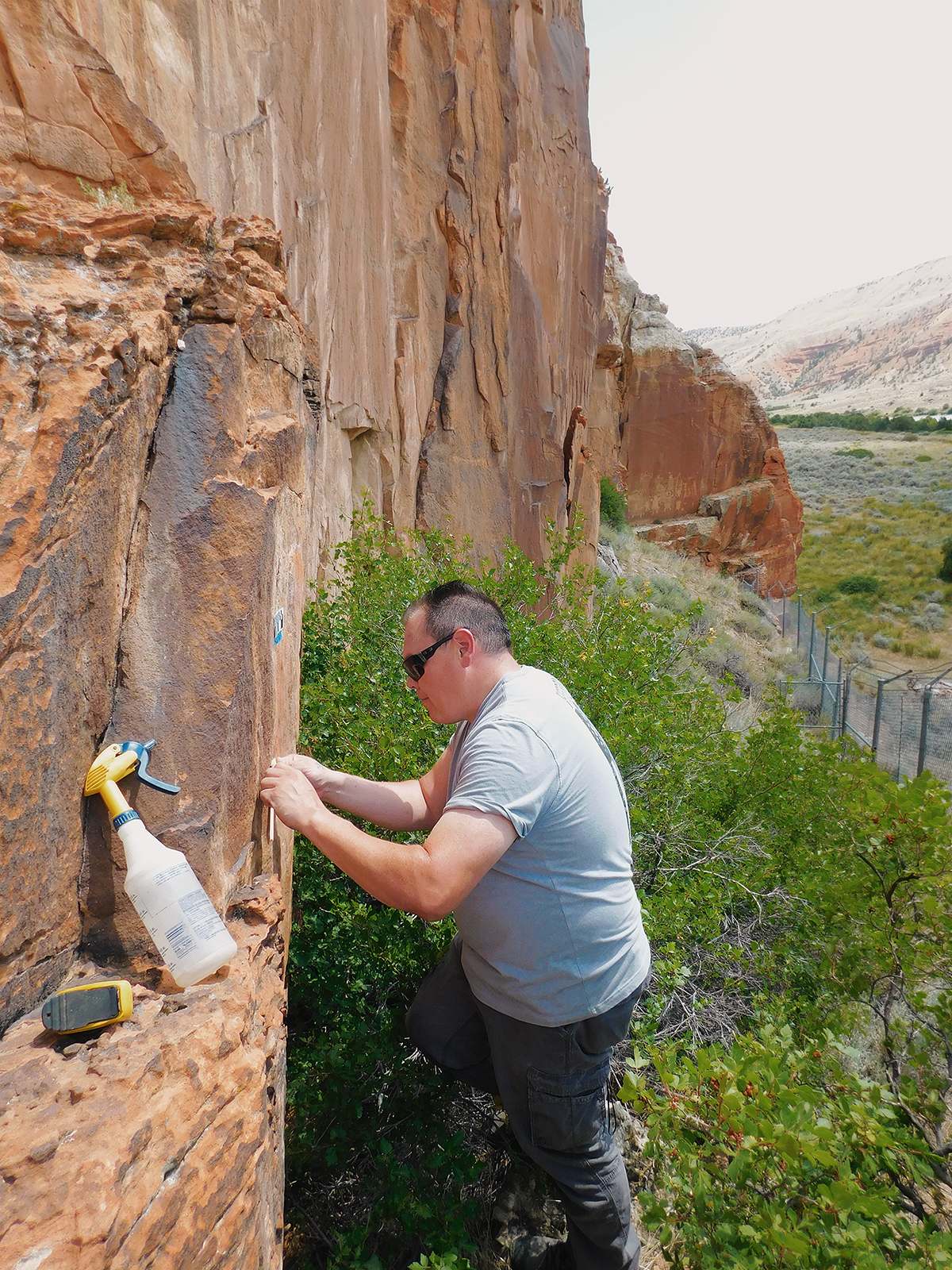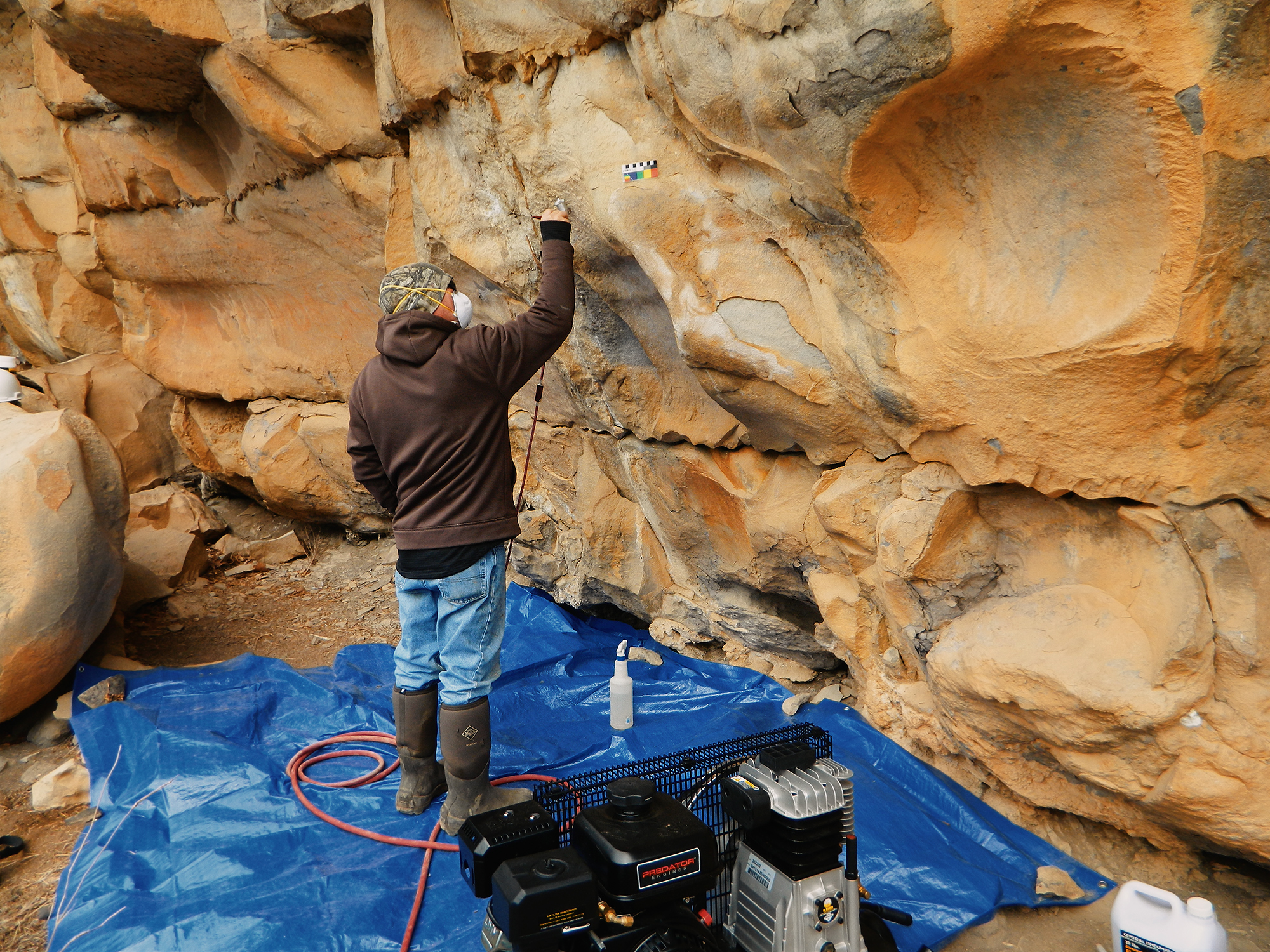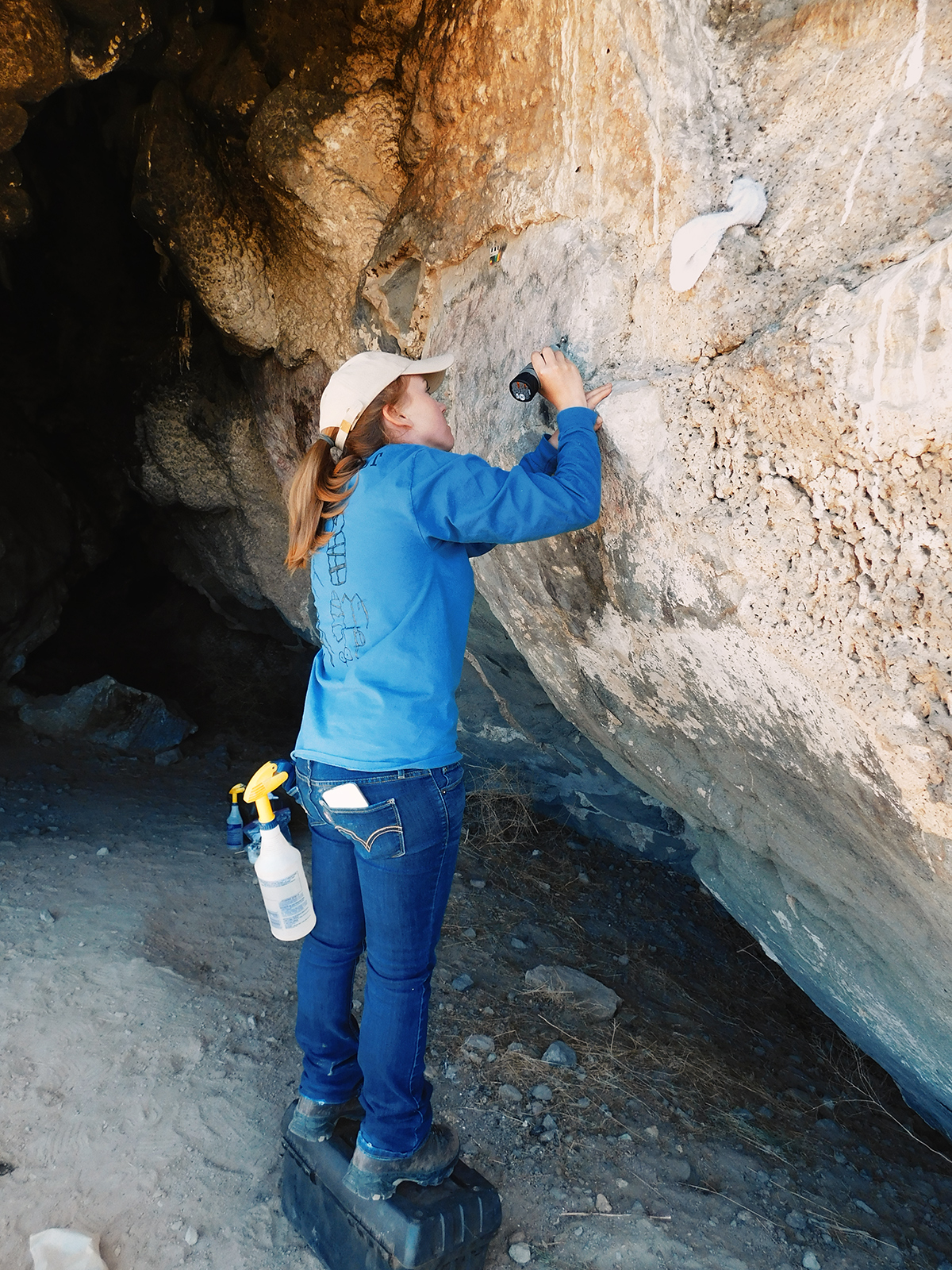


by Johannes H. N. Loubser
Stratum Unlimited
The intent of this paper is to highlight aspects of graffiti mitigation that I’ve found useful since my first removal exercise 30 years ago, without naming specific places, cultures, time periods, projects, products, or people. Instead of a manual on rock art conservation, this paper shows what works and what should be avoided as well as addressing certain misconceptions. Some rock art researchers fear that published descriptions of conservation techniques and materials will embolden “graffiti removal vigilantes” to conduct their own graffiti removal. I beg to differ on this account, mainly because “vigilantes” are going to remove graffiti in any case, frequently using techniques and materials that leave unsightly residues and scars. So, it’s preferable that people are made aware of advantages and pitfalls associated with hands-on conservation work.
Reasons why visitors decide to apply graffiti at a site are variable and hard to pin down with certainty, but probably have something to do with “domesticating” untamed spaces, such as by writing down their own names or initials, the names or initials of loved ones, faces, symbols, towns of origin, and dates of visits. The recognition of highly visible pictographs and petroglyphs can also be impetus for visitors to leave their own mark with the likely assumption that they have the same right as Indigenous peoples to do so. And of course, once graffiti is on the rock, it takes less impetus for other people to add their own marks. Unchecked, graffiti can cover in a short period entire rock art panels that have survived millennia of destructive natural agents.
Regular monitoring of sites after graffiti removal shows that graffiti re-appears on cleaned surfaces, mainly because the surfaces are close to vehicle access, are immediately adjacent to a trail, or are not in the viewshed of site managers. This shows that ease of access, lack of barriers to create a buffer zone, and absence of surveillance infrastructure are factors that facilitate graffiti, including on surfaces with no previous graffiti or where graffiti has been removed recently. Whereas graffiti removal and camouflage are necessary to prevent additional applications and to make the original rock imagery easier to see, only the implementation of workable visitor management infrastructure helps prevent incidences or re-occurrences of vandalism.
Knowing that easy vehicle access, nearby trails, lack of barriers, and no visible surveillance are factors facilitating graffiti, it behooves site managers to re-route vehicular and pedestrian traffic, install necessary buffers, and notify visitors of monitoring devices before removing graffiti. Changing the management infrastructure prior to mitigating the graffiti in the long run will save costs and the physical and aesthetic integrity of the rock surface from repeated removal and camouflage.
As in the case of plastic surgery, removal and camouflage of graffiti are invasive and can alter the rock surface forever. Because plastic surgery and hands-on graffiti mitigation run the risk of “going bad,” it is perhaps best not to take these actions unless considered essential. The decision wither graffiti mitigation is essential or not depends on many factors, a major one being how graffiti impinges on the main stakeholders’ views of a rock art site’s integrity. Importantly, the question should be addressed if graffiti detracts from, obscure, or destroy the spiritual, historical, research, ecological, and/or aesthetic significance of sites with rock imagery. There have been cases, for example, where major stakeholders were more concerned about the welfare of the surrounding vegetation and animal life or on the survival of historically significant graffiti than about the visibility of the older imagery and accordingly requested that graffiti not be removed (i.e., mainly due to uncertainty regarding trampling and chemical residues). Others have called for the employment of minimal removal techniques without any attempt at camouflage. Management contexts also play a role as to what measures are affordable or if follow-up treatments are sustainable. Accessibility to and availability of appropriate equipment and materials may help decide what can be done and what should not be attempted. Dark zone limestone caves, in which mineral accretions and other site alteration processes are quite active, are places where removal and camouflage are best not attempted. In most open-air settings, however, the presence of visually detracting graffiti creates the impression of custodial neglect which in turns facilitates neglect by visitors (i.e., the “broken windows” effect). If not properly conserved by site managers in an orderly fashion, sites will be “managed” by visitors, usually in a chaotic fashion. In most instances, proper management aiming at orderly appearances calls for visually detracting graffiti to be removed.
Prior to removal it’s imperative that a conservator has clear and accurate graphic information as to where original pictographs and petroglyphs start and stop and where graffiti occurs. To detect faint pictographs immediately before removal, it helps to enhance close-up cellphone photos with digital enhancement apps. Pecked, incised, and engraved petroglyphs are best detected under raking light, so it’s recommended that sites be recorded under different light conditions prior to removal. Blue masking tape temporarily attached to the rock helps delineate surfaces with pictographs and petroglyphs that should ideally be left untouched.
As part of documenting the history of site use and management, it helps to record graffiti prior to its removal. Personal names, dates, and names of towns are particularly useful to develop a profile of past visitation and vandalism patterns. Combined with information on the history of land ownership, changing management systems, and local population numbers, a summary of trends in graph format helps site managers understand changing patterns in visitation and vandalism. On federally managed land in the United States of America there is the so-called “fifty-year rule” that stipulates that no graffiti 50 years old or older should be removed. However, this rule is not equally applied at all sites, since other criteria might be preferable, such as wither or not people doing graffiti were intimately connected with the site and surrounding land.
Full-scale graffiti removal is normally preceded by testing of various techniques and materials. Testing should ideally be done on a surface removed from the main surfaces to be treated. In practice, however, each surface is unique in terms of aspect, topography, height, distance from the dripline, hardness, crusts, skins, flakes, textures, colors, biological activity, etc. For this reason, what works on one surface during testing is not guaranteed to work on adjacent surfaces. Different kinds of pictographs and petroglyphs also require different kinds of treatment; well-defined solid images (e.g.., solidly pecked or painted images) are generally easier to work around than scattered thin-lined ones (e.g., fine-line incised petroglyphs).
When removing graffiti, dry techniques are preferable to wet ones. When applying dry techniques, the use of soft materials is preferable to harder and more abrasive ones. When using liquids, less reactive and toxic ones should be tried first. Solvents and materials that are pH neutral and bio- degradable should be given priority. To conform to the principle of minimal interference camouflage should be avoided whenever possible but becomes necessary to infill lighter-colored “ghosting” often left after removing pigmented or incised graffiti (i.e., abrasion removes the darker outer mineral skin and exposes the lighter-colored inner rock). Native Americans tend to discourage camouflage, stating that removal is adequate and that the lighter-colored ghosting will eventually take on the color of the surrounding rock surface. In this assessment they are correct, but it probably takes a few generations for darker-colored mineral skins to develop. However, when it comes to damage that can only be better redressed through camouflage than through removal, such as bullet holes, Native Americans are known to support the application of color- matched pigment instead of opting for abrasive techniques.
No one solvent works on all graffiti. Acetone is a good solvent for removing brush tipped marker pen and nail polish graffiti. Alcohol works well for removing acrylic paint graffiti. Limonene or potassium hydroxide-based solvents dissolve enamel paints. A product that is a blend of potassium hydroxide and propriety chemicals has proved effective to remove tar-based silver roof paint from porous surfaces, but fares less well than limonene and straight potassium hydroxide on certain enamels. Very hardy cross-linked enamels that have baked into the rock surface can be removed with sodium hydroxide, a chemical that breaks the bond between the molecules that make up the paint instead of dissolving the paint. However, the use of sodium hydroxide is strongly discouraged for a variety of reasons, one being that even after thorough rinsing with water and absorbent towels, trace residues result in noticeable white stains many years later.
A viable and often successful alternative to using strong chemicals is to remove highly resistant graffiti with abrasive air. Inert corundum particles blasted at the graffiti with compressed air through a nozzle is an effective way to remove a wide range of materials but tend to bounce off from certain smooth spray paint enamels. Roughening up the surface with a steel wire brush might help the abrasive particles gain traction. The use of a rotating wire bush, powered by a hand-held electric drill, is an efficient way to speed-up removal of resistant pigment, but should be done after solvents have been applied and rinsed away with water. Advantages of using air abrasive is that it can accurately clean very small areas and its emulation of a rock surface’s texture, something that is difficult and time-consuming to achieve with brushing. Unfortunately, portable compressor units are not easy to obtain in rural areas and prohibitively time-consuming to transport across difficult terrain.
Air abrasion can also remove incised graffiti, although camouflage through in-painting with a sharp tipped brush works better for fine-lined incised graffiti. Pigments that can be used for in- painting vary from acrylics, through natural earth colors, to mineral silicates. The most successful being mineral silicates, bearing in mind that the colors are matched in a laboratory and the pigments lasts long since it forms a chemical bond with the particles on the rock’s surface and have micro-pores to allow water and salts to pass through. Acrylics have been applied successfully in the past but are difficult to color match and tend to weather away on surfaces that are exposed to rain and wind. Being a by-product of rock weathering, natural earth pigment powders are compatible with the rock. Mixed with water, natural earth pigments are easy to accurately color match with the rock. Applied to the rock surface with a paint brush, the wet pigment penetrates pores and interstices in the rock surface and so become anchored. To create a stronger physical bond between pigment and the rock surface it helps to vigorously rub the pigment with a leather glove. Charcoal powder, mixed with water, is an effective way to turn a shiny pigmented surface into a matt-textured one (i.e., at open-air sites, soot from natural wildfires adhering to rock surfaces creates a matt texture). Unfortunately, apart from red ochers and titanium whites, most natural earth pigments do not last long on surfaces that are exposed to rain and flowing water. Mineral silicate pigments last longer but in a couple of instances start to discolor after two years, making the meticulously infilled incisions appear brighter than before infilling. The reason for this discoloration is not known at present.
The difficulty to successfully or permanently blend fine-line incised graffiti with the surrounding rock can be circumvented by removing fine-line incisions via abrasion of the lines and the surrounding rock surface. Unfortunately, the removed surface, even if only paper thin, almost always leaves a lighter-color surface which needs camouflage so as not to stand out. It is important to note that camouflage of uneven and multi-colored surfaces is almost always more successful than doing it on flat and monochrome surfaces. The removal and camouflage of big surfaces usually require additional follow-up treatments.
Deeply incised graffiti marks are distinguishable by the shadows their edges cast, regardless of the color match between the incised surface and surrounding rock surface. To get rid of the shadows it becomes necessary to even out the angles of the graffiti’s edges, usually by adding water to create an abrasive slurry generated by vigorous brushing. Infilling deep graffiti with grout has virtually never proved successful, mainly due to the grout and parent rock having different expansion and contraction properties. Whereas camouflage with pigment should aim at emulating color variations and outlines on the rock surface (e.g., pale-colored salt flows), removing rock from a surface is an exercise in sculpting to emulate the natural rock topography (e.g., hollows resembling nearby natural ones).
Graffiti removal and camouflage creates a lot of residue and trash. Tarpaulins placed on the ground directly below the treated rock surface will capture corundum particles, for example. All used masking tape, dirty cotton wool balls, and emptied containers should be placed in trash bags and discarded off site.
Bearing in mind prevailing limitations in funding and time, removal and camouflage techniques sometimes diverge from ideal conservation principles, depending on the type and extent of graffiti. Steel dental picks are great when it comes to detailed, precise, and thorough removal of thin-lined pigmented graffiti, for example, a procedure that hardly leaves any stains or residues. In quite different circumstances, such as when massive painted graffiti letters and numerals occur high up against cliff faces or ceilings of rock shelters, removal and camouflage might involve the construction of scaffolding from local materials or attaching brushes to the ends of long poles.
Ideally, “less is more” when it comes to minimizing the visually distracting appearance of vandalism. For example, bullet holes can be made to blend with the rock surface by simply painting the top half with a light color and the bottom half with a darker color, thereby equaling out light and shadows created by sunlight. Typically, the less the number of treatments used, the less the need for follow-up treatments. But initial appearances can be deceptive, as the success of treatments can only be measured over a long period of time. For instance, what appears successful immediately after removal might discolor or re-appear decades later, or alternatively, tenacious markings that do not disappear during treatment can vanish after a few seasons of temperature and humidity shifts.
Most rock surfaces are forgiving and leave room for mistakes and follow-up treatments, many involving the successful application of new techniques, tools, and materials. Unfortunately, the same cannot be said of all graffiti modes of application and materials. Modern-day enamel spray paints penetrate pores and interstices in the rock surface to depths where solvents cannot reach without intensive abrasive brushing or air blasting. Moreover. exposed to sunlight and high temperatures, the organic molecules within enamels tend to cross link and create multiple bonds with the rock surface that are difficult to break. Deep incisions or incisions covering complicated petroglyph panels are also difficult to remove without broad-scale removal and camouflage of virtually the entire outer surface, excluding the rock art imagery.
Contrary to conventional wisdom, graffiti removal and camouflage do not provide long-term fixes; treated surfaces should be monitored on at least an annual basis, follow-up treatments need to be done wherever necessary, and management infrastructures need to be implemented to discourage vandalism. We know that houses need maintenance, not the least being intermittent re-painting of their exteriors. If this is true for houses with more-or-less the same walls, it’s even more so for rock surfaces, each with its unique blend of chemical and physical properties. However, unlike the orderly appearance of well-maintained houses, well-maintained pictograph and petroglyph sites should ideally retain their “chaotic” component.
I thank Janette Deacon, Neville Agnew, and Thomas McClintock for providing me an opportunity to write this paper. People from all walks of life, too numerous to thank personally, have made the recording and removal and camouflage of visually distracting graffiti possible, including conservators, archaeologists, indigenous communities, personnel from various agencies, site stewards, institutes, foundations, private landowners, camping and boating outfitters, volunteers, colleagues, law enforcement officers, the news media, youth groups, students, and family members. The range of hands-on participants is indicative of the positive support graffiti abatement enjoys among the general population. On numerous occasions people have gone out of their way thanking me and others for removing graffiti, something they almost never do after recording or excavating a site. This alone should tell us something what matters to the public at large.
→ Members and affiliated institutions of the Rock Art Network
by
George Nash
5/09/2024 Recent Articles
→ Sigubudu: Paintings of people with guns in the northern uKhahlamba-Drakensberg
by Aron Mazel
22/07/2024
by Richard Kuba
13/06/2024
by Meenakshi Dubey-Pathak
8/03/2024
by Rock Art Network
6/02/2024
by Rock Art Network
14/12/2023
by Sam Challis
5/12/2023
by Aron Mazel
30/11/2023
by Sam Challis
21/11/2023
by Sam Challis
15/11/2023
by Sam Challis
10/11/2023
by Rock Art Network
6/11/2023
by Rock Art Network
3/11/2023
by Aron Mazel
2/11/2023
by Meenakshi Dubey-Pathak
26/09/2023
by Paul Taçon
24/08/2023
by Aron Mazel
13/06/2023
by Paul Taçon
5/06/2023
by Paul Taçon
15/03/2023
by George Nash
14/03/2023
by Noel Hidalgo Tan
10/02/2023
by George Nash
01/02/2023
by Meenakshi Dubey-Pathak, Pilar Fatás Monforte
29/11/2022
by Aron Mazel, George Nash
21/09/2022
by Paul S.C. Taçon, Sally K. May, Ursula K. Frederick, Jo McDonald
07/07/2022
by Meenakshi Dubey-Pathak
26/07/2022
by Paul Taçon
20/07/2022
by David Coulson
16 June 2022
by Paul Taçon
25 April 2022
by Noel Hidalgo Tan
20 April 2022
by Meenakshi Dubey-Pathak
14 March 2022
by Carolyn Boyd & Pilar Fatás
02 March 2022
by David Coulson
07 February 2022
by Johannes H. N. Loubser
06 February 2022
by Meenakshi Dubey-Pathak
05 February 2022
by Aron Mazel
28 January 2022
by Aron Mazel
8 September 2021
by David Coulson
17 August 2021
by Ffion Reynolds
21 June 2021

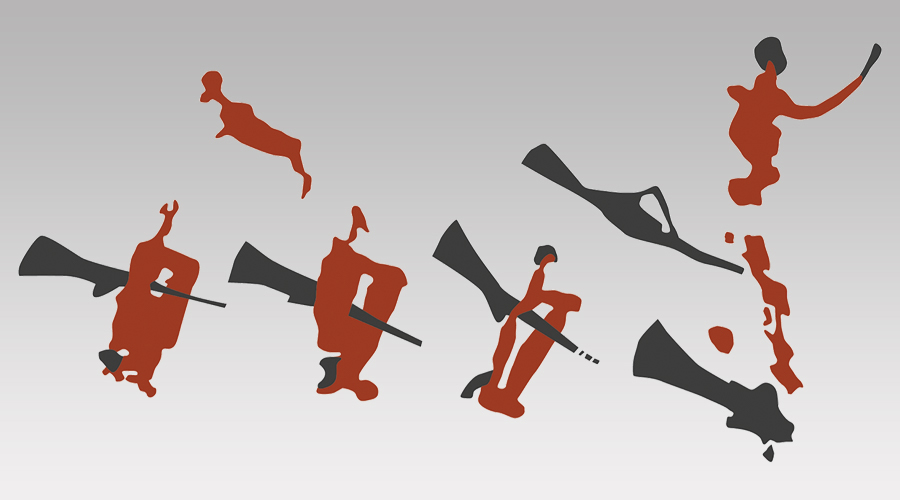
by Aron Mazel
22/07/2024
by Richard Kuba
13/06/2024
by Meenakshi Dubey-Pathak
8/03/2024
by Rock Art Network
6/02/2024
by Rock Art Network
14/12/2023
by Sam Challis
5/12/2023
by Aron Mazel
30/11/2023
by Sam Challis
21/11/2023
by Sam Challis
15/11/2023
by Sam Challis
10/11/2023
by Rock Art Network
6/11/2023
by Rock Art Network
3/11/2023
by Aron Mazel
2/11/2023
by Meenakshi Dubey-Pathak
26/09/2023
by Paul Taçon
24/08/2023
by Aron Mazel
13/06/2023
by Paul Taçon
5/06/2023
by Paul Taçon
15/03/2023
by George Nash
14/03/2023
by Noel Hidalgo Tan
10/02/2023
by George Nash
01/02/2023
by Meenakshi Dubey-Pathak, Pilar Fatás Monforte
29/11/2022
by Aron Mazel, George Nash
21/09/2022
by Paul S.C. Taçon, Sally K. May, Ursula K. Frederick, Jo McDonald
07/07/2022
by Meenakshi Dubey-Pathak
26/07/2022
by Paul Taçon
20/07/2022
by David Coulson
16 June 2022
by Paul Taçon
25 April 2022
by Noel Hidalgo Tan
20 April 2022
by Meenakshi Dubey-Pathak
14 March 2022
by Carolyn Boyd & Pilar Fatás
02 March 2022
by David Coulson
07 February 2022
by Johannes H. N. Loubser
06 February 2022
by Meenakshi Dubey-Pathak
05 February 2022
by Aron Mazel
28 January 2022
by Aron Mazel
8 September 2021
by David Coulson
17 August 2021
by Ffion Reynolds
21 June 2021
Friend of the Foundation


by Aron Mazel
22/07/2024
by Richard Kuba
13/06/2024
by Meenakshi Dubey-Pathak
8/03/2024
by Rock Art Network
6/02/2024
by Rock Art Network
14/12/2023
by Sam Challis
5/12/2023
by Aron Mazel
30/11/2023
by Sam Challis
21/11/2023
by Sam Challis
15/11/2023
by Sam Challis
10/11/2023
by Rock Art Network
6/11/2023
by Rock Art Network
3/11/2023
by Aron Mazel
2/11/2023
by Meenakshi Dubey-Pathak
26/09/2023
by Paul Taçon
24/08/2023
by Aron Mazel
13/06/2023
by Paul Taçon
5/06/2023
by Paul Taçon
15/03/2023
by George Nash
14/03/2023
by Noel Hidalgo Tan
10/02/2023
by George Nash
01/02/2023
by Meenakshi Dubey-Pathak, Pilar Fatás Monforte
29/11/2022
by Aron Mazel, George Nash
21/09/2022
by Paul S.C. Taçon, Sally K. May, Ursula K. Frederick, Jo McDonald
07/07/2022
by Meenakshi Dubey-Pathak
26/07/2022
by Paul Taçon
20/07/2022
by David Coulson
16 June 2022
by Paul Taçon
25 April 2022
by Noel Hidalgo Tan
20 April 2022
by Meenakshi Dubey-Pathak
14 March 2022
by Carolyn Boyd & Pilar Fatás
02 March 2022
by David Coulson
07 February 2022
by Johannes H. N. Loubser
06 February 2022
by Meenakshi Dubey-Pathak
05 February 2022
by Aron Mazel
28 January 2022
by Aron Mazel
8 September 2021
by David Coulson
17 August 2021
by Ffion Reynolds
21 June 2021
Friend of the Foundation
